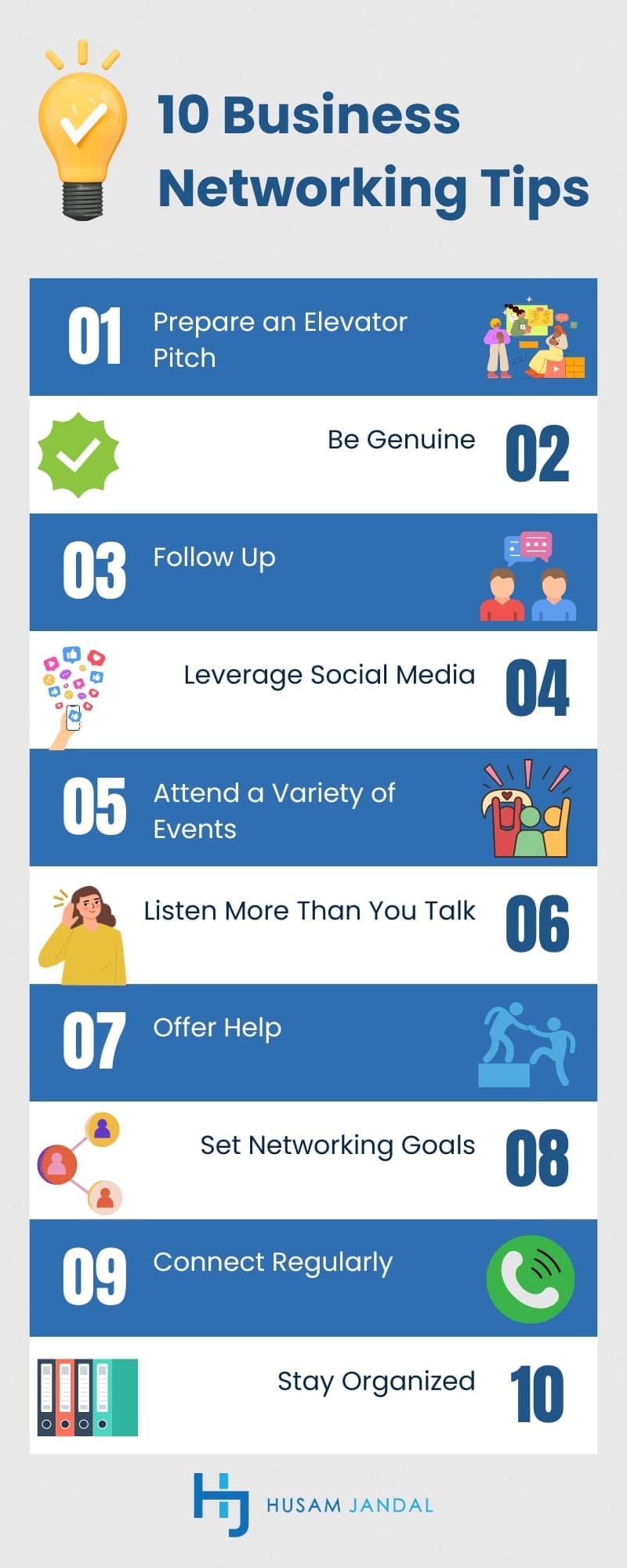 Imagine entering a room full of potential business allies, with each conversation serving as a doorway to new opportunities and shared success. This is the power of networking in the modern business landscape. Give me a few minutes, and I’ll walk you through the benefits of networking, give you tips to boost your success and show you how to turn your new connections into allies so that the scenario above can become your reality.
Imagine entering a room full of potential business allies, with each conversation serving as a doorway to new opportunities and shared success. This is the power of networking in the modern business landscape. Give me a few minutes, and I’ll walk you through the benefits of networking, give you tips to boost your success and show you how to turn your new connections into allies so that the scenario above can become your reality.
Why Networking in Business is Essential
Before we get into the details, let’s take a quick look at what makes networking such a powerful entrepreneurial tool.
You Gain Access to Resources and Knowledge
Networking provides entrepreneurs access to essential resources and expertise they may not have internally. This can include advice from more experienced entrepreneurs, access to industry insights, and practical tips on navigating challenges. For instance, a startup might connect with a venture capitalist or an industry expert through a networking event, leading to mentorship or investment.
You May Find Opportunities for Collaboration
Through networking, small businesses and startups often find opportunities to collaborate, which can lead to new business or innovation. A good example is the collaboration between startups and established firms where both can co-develop products. In tech, for instance, larger firms often partner with nimble startups to integrate innovative technologies into their existing offerings, benefiting both parties.
It’s Helpful for Building Brand Visibility and Reputation
Engaging with other business professionals and participating in industry events can raise a company’s profile and build its reputation within the industry. Networking at events like trade shows or local business groups can significantly increase a company’s visibility, often leading to customer referrals and new opportunities.
You Can Develop Strategic Alliances to Boost Growth
Strategic alliances can be a crucial growth lever. These alliances allow businesses to pool resources, share risks, and leverage each other’s strengths. For example, a startup might form an alliance with a distribution company to access a broader market, significantly speeding up its growth potential. A historical example includes the alliance between Starbucks and Barnes & Noble, which combined Starbucks’ coffee with Barnes & Noble’s books, enhancing the customer experience and drawing more foot traffic to both businesses.
You May Enhance Your Business Capabilities
Networking can lead to partnerships that fill gaps in capabilities without the overhead of developing those functions in-house. For instance, a small tech firm might partner with a larger marketing agency to leverage its reach and expertise, allowing the tech firm to focus on product development while the marketing agency handles the promotion.
Business Networking Tips

Applying a few helpful tips can significantly enhance the effectiveness of your networking efforts, leading to more fruitful professional relationships and opportunities.
Prepare an Elevator Pitch
Have a concise, clear summary of who you are, what your business does, and what you’re looking for. This will help you communicate effectively and allow you to make a strong first impression, even during brief interactions.
Be Genuine
Authenticity is vital to building lasting relationships. Engage sincerely in every conversation and show genuine interest in the other person’s business and challenges.
Follow Up
After meeting someone, follow up with a brief message or email acknowledging the meeting and expressing interest in staying connected. This helps to solidify the relationship and shows you value the connection.
Leverage Social Media
Seven in ten small business owners leverage social media for networking purposes, Zippia reports. Utilize platforms like LinkedIn to connect before and after in-person meetings. This can help you maintain the connection and ensure you stay in the loop.
Attend a Variety of Events
Participate in a variety of networking events, not only those specific to your industry, so you can build connections outside your immediate field.
Listen More Than You Talk
Listening is an underrated aspect of networking. By listening, you can learn about others’ needs and how you might be able to help them, which is a cornerstone of effective networking.
Offer Help
Be willing to assist others. Whether sharing knowledge and resources or making introductions, helping others can foster goodwill and encourage others to support you in return.
Set Networking Goals
Before attending networking events, set clear objectives about what you want to achieve, such as meeting a certain number of new people or finding potential partners in specific areas.
Connect Regularly
Regular communication keeps the relationship alive and ensures you’re top of mind when opportunities arise. Engage with your network through various channels often.
Stay Organized
Keep track of the people you meet, the context of your interactions, and follow-ups. Tools like customer relationship management (CRM) software or simple spreadsheets can help manage your contacts effectively.
Tactics for Building Strategic Alliances
Applying a few additional strategies can help ensure your strategic alliances are formed with the right intentions and are managed effectively to maximize their potential benefits.
Identify Complementary Businesses
Look for businesses that complement yours rather than compete with it. This could be in terms of customer base, products, services, or market reach. Partnering with these businesses can create synergistic effects that benefit all involved.
Define Clear Objectives
Before entering into any alliance, clearly define what each party hopes to achieve. This clarity helps align goals and ensures all parties progress toward a common objective.
Perform Due Diligence
Research potential partners and conduct due diligence. Understand their business model, market reputation, cultural fit, and financial health to ensure they align with your business values and goals.
Create a Formal Agreement
Document the partnership terms in a formal agreement. This should include roles, responsibilities, resources each party will contribute, profit sharing, and exit strategies.
Communicate Regularly
Effective communication is vital to the success of partnerships. Establish regular check-ins and updates to discuss the alliance’s progress, address any issues, and make adjustments as needed.
Leverage Each Other’s Networks
Each party brings its own unique network of contacts. Actively look for ways to leverage these networks for mutual benefits, such as cross-promotions, joint marketing campaigns, or co-hosted events.
Start Small
Begin with a small project or a trial period to assess the partnership’s dynamics. This allows both parties to evaluate the collaboration’s effectiveness before committing to more significant investments.
Build Trust
Honor commitments and demonstrate reliability. Building trust takes time, but it’s essential to a long-term and successful strategic alliance.
Measure Performance
Set up metrics to measure the success of the alliance. This can involve financial performance, customer satisfaction, market reach, or other key performance indicators relevant to the alliance’s goals.
Plan for Conflict Resolution
Establish mechanisms for resolving disagreements or conflicts that may arise. Having a clear, agreed-upon process for conflict resolution may help you maintain the stability and integrity of the partnership.
Plan for Growth
Next, let’s review how to plan for growth through networking below.
Set Goals for Networking and Partnership Development

- Define Specific Objectives: Start by identifying what you want to achieve through networking. This could include expanding into new markets, accessing new technology, increasing brand awareness, or sourcing new suppliers. Clear objectives guide your networking efforts and help you target the right events and contacts.
- Segment Your Network: Categorize your network into segments such as potential clients, potential partners, influencers, and mentors. This allows you to tailor your approach and messaging to each group, increasing the effectiveness of your interactions.
- Develop a Timeline: Create a timeline for achieving your networking goals. This might include short-term goals (e.g., meeting five potential clients per month) and long-term goals (e.g., forming two new strategic partnerships within a year).
- Allocate Resources: Decide how much time, effort, and money you are willing to invest in networking activities. This includes attending events, hosting meetings, and following up on contacts.
Measure the Success of Your Networking Efforts
- Track Lead Generation: Monitor the number of leads generated through networking efforts and the conversion rate of these leads into customers. This makes it easier to assess the direct impact of networking on sales.
- Evaluate Partnership Efficacy: Assess the success of strategic alliances and partnerships based on predefined metrics such as revenue growth, cost savings, market expansion, and product or service improvements.
- Use Feedback Mechanisms: Collect feedback from networking contacts and partners about their experiences interacting with your business. This can provide insights into how well your networking strategies are being received.
- Review Network Growth: Regularly review the size and quality of your network. Are you connecting with the right people? Is your network growing in a way that supports your business objectives?
- Analyze Return on Investment (ROI): Calculate the ROI of your networking activities by comparing benefits like increased sales, cost savings, and market information against the costs such as event fees, travel costs, and time spent.
Integrate Networking into Your Business Strategy
- Strategic Alignment: Ensure networking efforts align with your overall business strategy. For instance, if the strategy prioritizes market expansion, networking activities should focus on connecting with potential clients and partners in new markets.
- Employee Involvement: Encourage key team members to participate in networking. This distributes the workload and brings diverse perspectives and opportunities into the business.
- Leverage Technology: Utilize CRM systems to manage contacts, track interactions, and schedule follow-ups. Technology can also help identify networking opportunities and analyze data to gauge the effectiveness of your networking strategy.
Get Help Tapping into the Power of Networking
In addition to providing avenues for virtual networking, many areas of digital marketing, such as branding, email, and social media marketing, can also help strengthen your in-person networking strategies. If you’d like to take a well-rounded approach to boosting your online presence, I can help. Please contact me for a complimentary consultation.

Business Networking FAQs
How can I start networking if I’m new to my industry?
Begin by attending industry-specific events, workshops, and seminars to meet peers. Join relevant online forums and professional groups on platforms like LinkedIn to engage in discussions and connect with industry leaders.
What are the best ways to network effectively at business events?
Prepare an elevator pitch, set specific goals for each event, like meeting three potential clients or talking to five potential partners, and follow up promptly with new contacts post-event to reinforce the connections.
How can I use online platforms to enhance my business networking?
Leverage platforms like LinkedIn to create a professional profile, join industry groups, share insightful content, and engage with others’ posts. Use these platforms to arrange face-to-face meetings or virtual catchups.
What are some common mistakes in business networking and how can I avoid them?
Common mistakes include not following up with contacts, talking too much about oneself, and failing to listen actively. Avoid these by being consistent in your follow-ups, focusing on how you can help others, and actively listening during conversations.
How do I measure the success of my networking efforts?
Track the number of meaningful connections made, assess the quality and outcomes of these relationships, like partnerships or sales, and evaluate the return on investment from time and resources spent on networking activities.
What are the benefits of forming strategic alliances through networking?
Strategic alliances can provide access to broader markets, shared resources, enhanced credibility, and the potential for innovation by combining the strengths and capabilities of different businesses.
How often should I engage with my network to maintain effective relationships?
Regular engagement is key. Try to touch base with your network at least once every quarter through emails, social media interactions, or face-to-face meetings to keep the relationships active and beneficial.
Can networking help me find mentors or advisors for my business?
Yes, networking is an excellent way to find mentors and advisors. It allows you to connect with experienced professionals who can offer guidance, provide feedback, and support your business growth.
How can I turn a networking contact into a lasting business relationship?
Focus on building trust through consistent and mutual exchanges of value, being reliable, and always looking for ways to support and add value to the other party's endeavors.




































































